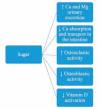Not Salt But Sugar As Aetiological In Osteoporosis: A Review
- PMID: 30228731
- PMCID: PMC6140170
Not Salt But Sugar As Aetiological In Osteoporosis: A Review
Abstract
Salt has notoriously been blamed for causing an increase in the urinary excretion of calcium, and thus is a considered a risk factor for osteoporosis. However, the increase in the urinary excretion of calcium with higher sodium intakes can be offset by the increased intestinal absorption of dietary calcium. Thus, the overall calcium balance does not appear to be reduced with a higher sodium intake. However, the other ubiquitous white crystal, sugar, may lead to osteoporosis by increasing inflammation, hyperinsulinemia, increased renal acid load, reduced calcium intake, and increased urinary calcium excretion. Sugar, not salt, is the more likely white crystal to be a risk factor for osteoporosis when overconsumed.
Figures
Similar articles
-
Review of risk factors for osteoporosis with particular reference to a possible aetiological role of dietary salt.Food Chem Toxicol. 2000 Feb-Mar;38(2-3):237-53. doi: 10.1016/s0278-6915(99)00145-3. Food Chem Toxicol. 2000. PMID: 10717363 Review.
-
Role of dietary sodium in osteoporosis.J Am Coll Nutr. 2006 Jun;25(3 Suppl):271S-276S. doi: 10.1080/07315724.2006.10719577. J Am Coll Nutr. 2006. PMID: 16772639 Review.
-
Dietary salt, urinary calcium, and bone loss.J Bone Miner Res. 1996 Jun;11(6):731-6. doi: 10.1002/jbmr.5650110603. J Bone Miner Res. 1996. PMID: 8725169 Review. No abstract available.
-
The kidney and essential hypertension: a link to osteoporosis?J Hypertens. 1993 Aug;11(8):781-5. doi: 10.1097/00004872-199308000-00003. J Hypertens. 1993. PMID: 8228200
-
Influence of dietary sodium intake on urinary calcium excretion in selected Irish individuals.Eur J Clin Nutr. 1988 Jul;42(7):595-603. Eur J Clin Nutr. 1988. PMID: 3224603
Cited by
-
Associations between special diet and incidence risk of osteoporosis: a Mendelian randomization study.Front Public Health. 2024 May 30;12:1364735. doi: 10.3389/fpubh.2024.1364735. eCollection 2024. Front Public Health. 2024. PMID: 38873319 Free PMC article.
-
The association between dietary sodium intake and osteoporosis.Sci Rep. 2022 Aug 26;12(1):14594. doi: 10.1038/s41598-022-18830-4. Sci Rep. 2022. PMID: 36028560 Free PMC article.
-
Effects of vegetarian diet on bone mineral density.Tzu Chi Med J. 2020 Sep 16;33(2):128-134. doi: 10.4103/tcmj.tcmj_84_20. eCollection 2021 Apr-Jun. Tzu Chi Med J. 2020. PMID: 33912409 Free PMC article. Review.
-
Effect of salt substitution on fracture-a secondary analysis of the Salt Substitute and Stroke Study (SSaSS).BMC Med. 2024 Sep 4;22(1):366. doi: 10.1186/s12916-024-03586-7. BMC Med. 2024. PMID: 39232779 Free PMC article. Clinical Trial.
-
High Consumption of Sugar-Sweetened Beverages Is Associated with Low Bone Mineral Density in Young People: The Brazilian Birth Cohort Consortium.Nutrients. 2023 Jan 9;15(2):324. doi: 10.3390/nu15020324. Nutrients. 2023. PMID: 36678194 Free PMC article.
References
-
- Eaton-Evans J. Osteoporosis and the role of diet. British journal of biomedical science. 1994;51(4):358–70. - PubMed
-
- Kanis JA, Delmas P, Burckhardt P, Cooper C, et al. Guidelines for diagnosis and management of osteoporosis. Osteoporosis International. 1997;7(4):390–406. - PubMed
-
- Delmas PD. Treatment of postmenopausal osteoporosis. The Lancet. 2002;359(9322):2018–26. - PubMed
-
- Reginster J-Y, Burlet N. Osteoporosis: a still increasing prevalence. Bone. 2006;38(2):4–9. - PubMed
Publication types
MeSH terms
Substances
LinkOut - more resources
Full Text Sources
Medical
Research Materials



